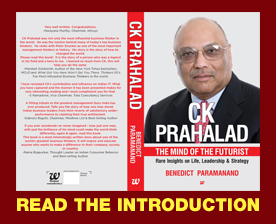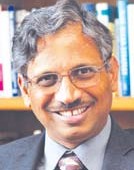 Indian Universities are opening up and are
Indian Universities are opening up and are
offering degrees for private courses
Ashwin Ajila’s i-Nurture is pioneering industry-academia collaboration using innovative business models. He is starting with seven universities and if others replicate his model, India’s education sector could find a tipping point very soon
With Toonskool, Ashwin’s was the first private education venture to get a university approved degree course in animation. i-Nurture is also the first to have its post-graduate programs approved and delivered on-campus, in partnership with a UGC-approved university. i-Nurture is today at the forefront of bridging the gap between university approved mainstream courses and industry requirements.
Ashwin has management and business of education in his blood. His family manages the famous Nitte Education Trust. In 25 years, the trust has grown to run over 30 institutes and is ranked second only to Manipal University in the education city of Mangalore, Karnataka. He tells Benedict Paramanand, Editor of ManagementNext, how he dropped his ambition of becoming a well-paid bean counter at KPMG London the very first day he qualified for the job to follow up passion
What’s unique about your model?
We set up the company in 2005 but we went into a commercial launch in 2007. There was a clear understanding about the constraints in the regulated education market. Based on that we started with animation which was completely a new field and we felt getting animation into a regulated market, following the norms and structures at the university was going to be a problem. So that’s how ToonSchool came into being. The question was – how do we integrate industry and academia innovatively. The timing was actually perfect. When we first looked at this model the only university that agreed to look at it was an open university. We started with KSOU, Karnataka State Open University. Everyone thought that this model would work only with an open university system, so did we. Because of credibility issues in distance/open education system we realized we had to move into the jurisdictional model soon. The easiest way to scale in this model was not to invest into brick and mortar but work with universities and be their delivery partner.
To get the industry excited I needed to go to leaders with 20 or 30 campus portfolio. That’s when I would be fulfilling the pipeline that they require. So the only way to do that was to go through a distributive model and to scale to that model, brick and mortar wasn’t the way.
So we said, ‘let’s invest in content and let’s get the industry involved in it; let’s do a model where brick and mortar is put in by somebody else. We were clear that we could obtain scale only by focusing on industry relevant content and the right faculty. So that’s how the model shaped up and our first offering was animation.
The next course we offered was mobile which the industry wanted. The industry understood our model and since they had no bandwidth to interact with several universities, they picked us whole heartedly. They are also willing to give the IP to train our trainers and we also are happy to offer jobs.
Our role was that of a facilitator. I like to put it in a technology term – I have a platform and the industry is the application, so there is mobile, security, cloud. Our deal was – As long as you have that application which is the content and the curriculum, you plug into my platform and I will do the rest.
The second vertical we moved into was media. Top media executives Lakshmi Narayan, commercial director at Mudra and Ramesh Ramanathan, creative director at Saatchi & Saatchi approached me. They told us – we know how to teach advertising and media but we cannot run around universities, manage faculty but what we can do is create an excellent curriculum and help you with the industry network to ensure placement.
Today we have 7 verticals and we have two more in the pipeline. We have request for software testing, analytics, and an American university wants us to start food systems, biology.
People experienced in the industry, who know what the industry requires, or people who have been in training post recruitment in an industry are willing to join us and take this model forward. We offer equity participation in their business so that there is a long term commitment and a sense of ownership.
It took us 5 years to get the first 6 universities, in the last 6 months we have signed up 7. By this academic year we will have 20 partners. In the next three years we are looking to have 50 partners.
Today, when I talk about 20 universities and 50 universities in 3 years, the biggest investments will be on e-learning. And the constraint on tying up with more universities is not technology, it’s the big gap in the supply of good faculty.
Technology challenges
Technology is available but intelligent conversion of the legacy content with the e-platform is something that we are trying to understand. We are trying to get the highest quality of content and high level of comfort to our stake holders. How much of delivery can happen on the e-learning platform will depend on the acceptance of the universities and the government in the blended model. It’s not a question whether that’s going to happen; it’s a question when it’s going to happen. When that happens, scale will not be a problem. We can partner as many universities as technology supports.
Faculty is a huge constraint in India
We have already started doing a lot on the virtual classroom platform so that’s going to help us scale because the question today is not about the middle rung assistant professors , the deficit is among specialized faculty. Now there is a greater acceptance by the partners for teaching 60 hours or 90 hours from virtual classroom platform. This way, the faculty requirement can be brought down to three specialists from 20.
The response to a pilot plan is quite positive from both the partners and students. Bandwidth is still a problem for reaching remote locations. The Gujarat government wants us to offer 135 hours of vocational training to every single government college. In Gujarat there are 200 of them, as a pilot with 100 students in each. It could go up to 800-900 colleges soon. The challenge is how we deliver good content on lower bandwidth. AURUS could be a game changer. We are working with them.
The cost of technology is falling so drastically, you think the governments can afford to offer high bandwidth to every college?
Where there is will there is a way. The infrastructure in colleges today is depleted. They can’t even fix windows, broken furniture, forget 3G. Some universities are facing salary issues. So whether it’s a crunch or universities over shot costing I don’t know. I don’t complain about it. In fact, because of their problem I have a great model!
One of the other reasons why the acceptance of our partners has become higher is for two reasons. The private colleges today have built infrastructure but need to build profit lines. And the government bodies have told colleges that they can offer selffinancing plug-and-play courses. Any revenue is welcome for everybody. The public universities are also open to joint development of their vast land for launching new courses. We are introducing the emerging sector top end courses for which placement is guaranteed. This is our unique model and we have the first mover advantage. People keep asking me what about competition? Right now the market is so big that what we are doing is still the tip of the iceberg.
Are you similar to the finishing school then?
No. Companies like Pearson and YGen are going to universities setting up their labs but they do 60 hours of soft skills but nobody has yet partnered a college to offer a full-fledged degree program.
We need more players to make this model visible – There are 600-800 universities I can do 50-100-150, so it’s a very huge market out there and I think the momentum that’s gone into government and private sector working together in education cannot be stopped now.
We were lucky that we were able to sustain it in the first 4-5 years because people believed in the model but it was a question of when would it actually take off. We had 4-5 years of challenges, the timing was perfect. This year it surprised us. Presently, we are in talks with 27 more universities that look positive.
Can’t you use a franchisee model to scale?
Again the constraint is going to be faculty. It’s not about any other issue. If anybody can get faculty it’s us, not a franchisee, not a university because with the scale that we have got we can effectively use faculty across our campuses, centralize it, delivery through virtual classrooms.
Where industry sees opportunity
The industry is beginning to like our model. They need easy access to people but have no clue how to get them other than the conventional ways. They are ready to offer content/curriculum. I happened to meet Arjun Singh, MD of Aon Hewitt, Raman Roy, founder of Quatrro BPO Solutions and Pramod Bhasin of Genpact at a conference. Raman said we recruit 15,000 people a year, we train them for 6 months, out of the 15 thousand, six thousand leave. Then I poach Pramod, he poaches me, this can’t go on. So why don’t we work with you, it’s a larger opportunity, and do you realize you have captive students with you who aren’t your students.
So that’s very exciting for us when industry sees us as a platform to link them to universities, create a better pipeline for them at the pre- recruitment stage. They believe that a student has more responsibility when he has paid for training rather than when he gets it free from us. The Indian mind sees vocational training as the third level of education therefore we make it as part of the mainstream education. It’s a win-win situation.
What is career integration?
Everybody is talking about employability that is at the entry level of a job. What we are trying to do is integrating not just the technical aspect, but also what is required as a person grows in his career. Certain elements of career growth should be built into a student. Ideally we would like to do a lot more integration. For example, Infosys came to us on IT security and the government has made it mandatory for every university to offer IT security courses. We are the first movers in that. Once you get into a university, mining the opportunity there is very large. Universities welcome us because we have 20 private sector partners signed up already. They see Manipal University or NIIT as their competition.
Any innovative ways of plugging faculty shortage?
We are looking to tap into people who have completed 20-25 years within the industry and want to give back. We have a few of them who have said we would love to be your evangelists. We are inviting them to our board of advisors, telling them what they can do. We are tapping into retired academicians as well.
We are also getting people from the industry to put in a few hours and secondly we have started our own faculty training center. Initially we were averse to do that because some may join the competition. Today, we aren’t so bothered; even if we can retain 50%, that’s the value add we are looking at. Today our resources enable us to keep faculty on bench, using them for content development if required.
Are you already profitable?
Not yet. Animation is supporting other verticals. With our second round of funding, it’s not a concern anymore, we hope to be profitable by 2014. It also depends on how many more verticals we launch.
We are yet to get into enterprise training. We have started developing content for SBI on the e-learning platform. We have developed training material for Reliance for their shop floor people and to build that into a degree. This is to reduce attrition which in retail today is 180%/year and they want to bring it down to 100%!
Recent months have been very exciting and challenging because there are so many opportunities around but you need to be smart. There is always a temptation, an Indian mindset to grab anything that comes you way. We have to pick and choose.











Recent Comments